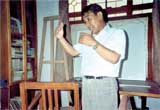Textbooks on speech

Ngawang Dorjee describes the process of creating textbooks for the TCVs.
When writing textbooks for the Tibetan Children’s Villages, writers reference classic Tibetan texts, Tibetan textbooks from the pre-occupation era, as well as European and American textbook.
Historically, there are two forms of written Tibetan — a form used by the lower class that involves an intricate vowel: consonant interaction in its calligraphy, and a form used by the educated class that utilizes a much simpler system of writing, but a more advanced vocabulary.
Today, the lower form of Tibetan is used in the introduction of the Tibetan language to young students; specifically, until the third grade, at which time the higher form of Tibetan is gradually introduced.
The vowel-consonant interface in the calligraphy mandates that the textbooks for grades three and lower must be handwritten and then scanned into a computer.
No word processing program exists for the lower form of Tibetan, making the production of text for the lower grades of the Tibetan Children’s Villages school system tedious and labor-intensive.
The director of textbook development at the Education Development and Resource Center of the Tibetan Children’s Villages is former Tibetan language teacher Ngawang Dorjee.
Dorjee taught grades one through twelve at the Dharamsala TCV until 1994, at which time he was asked to direct the textbook development division of the EDRC.
He and his family were living on the Tibetan side of the Tibet-Nepal border when the Chinese invaded Tibet in 1959. After the onset of the occupation, Dorjee’s family moved to a Sherpa village in Nepal in which Tibetan was spoken and they resided there for two years. Then, when Dorjee was six years old, he was sent to the Mussoorie School in India for education.
He completed his primary education at Mussoorie, and went on to a teacher’s training course in Bangalore. He then spent a year in the Indian military, and by 1979, the education system for Tibetans in Exile was advanced enough that he was able to teach refugee children at the still-developing Tibetan Children’s Village of Dharamsala.
Dorjee said the written Tibetan language has not been the same since 1959. In pre-occupation Tibet, the language was written with a bamboo pen on a piece of wood. He said in this era, the calligraphy was emphasized, almost to the point of taking ritual form.
“Now there is no time,” he said. “More importance is given to the content than the form.”
Dorjee has spent many years in the teaching and study of the Tibetan language, and has seen it grow and change in the under 50 years since the invasion.
Hindi and English influences on the Tibetan language are noticeable as the majority of young Tibetans receive their primary education in India and a new generation of children born to Tibetans in exile matures into the next educated generation of Tibetans. There is an increasing number of young people speaking Tibetan in a modified form, and so the language is being evolved according to the young speakers’ tastes.
The Tibetan language has only one sound, whereas Hindi has short and long sounds. In Tibetan, the vowel follows the consonant, as the last sound, whereas in English the vowel comes first.
Young speakers use a new order and length in the sounds of the Tibetan language, drawn from their exposure to the primary languages of India.
There are 30 consonants and four vowels in the Tibetan language, which is derived from ancient Sanskrit. The language faces an obstacle in the new terminology necessitated by advances in science, mathematics and technology. There is no uniformity in the creation of new words for new concepts, which often to miscommunications among Tibetans from differing regions.
After a detailed explanation of the development of Tibetan textbooks and a tour of the Education and Development Resource Center, Dorjee became pensive.
“The Tibetan language is our culture,” he said, “The culture must be taught in order to save it, but it must be taught in its native language, a language whose life is threatened daily.”
Your donation will support the student journalists of Missouri Southern State University. Your contribution will allow us to purchase equipment and cover our annual website hosting costs.



























